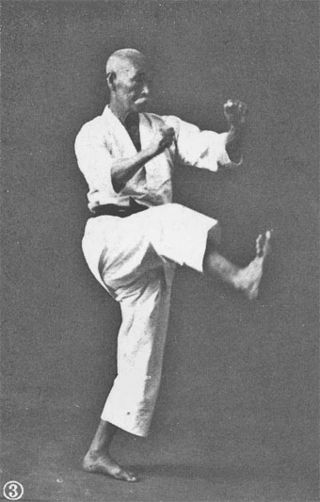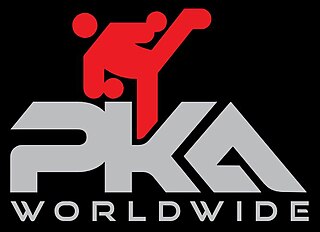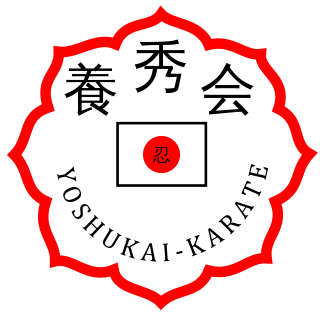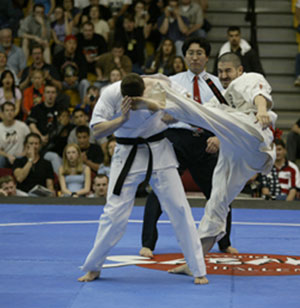Related Research Articles

Karate (空手), also karate-do, is a martial art developed in the Ryukyu Kingdom. It developed from the indigenous Ryukyuan martial arts under the influence of Chinese martial arts. While modern karate is primarily a striking art that uses punches and kicks, traditional karate also employs throwing and joint locking techniques. A karate practitioner is called a karate-ka (空手家).

Count Juan Raphael Dante was an American martial artist figure during the 1960s and 1970s who claimed he could do extraordinary feats such as Dim Mak.

Tang Soo Do is a Korean martial art based on karate and can include fighting principles from taekkyeon, subak, as well as northern Chinese martial arts. From its beginnings in 1944 to today, Tang Soo Do is used by some Kwans to identify the traditional Korean fusion of fighting styles. In the mid 1950s, it became the basis for the martial art taekwondo when the Korean Nine Kwans united.

Robert A. Trias was an American karate pioneer, founding the first karate school in the mainland United States and becoming one of the first known American black belts. He also developed Shuri-ryū karate, an eclectic style with roots in Chinese kung-fu, and indirectly some Okinawan karate.
Shuri-ryū (首里流) karate is an eclectic martial arts system developed by Robert Trias (1923–1989), reportedly the first Hispanic to teach a form of karate in the mainland United States, who opened his public first dojo in 1946 in Phoenix, Arizona.

The ISKA is one of the major international bodies regulating sport karate and kickboxing matches. It is based in the United States. It was established in 1985 as a response to legal and revenue issues that sent the Professional Karate Association (PKA) into decline.

Joe Lewis was an American martial artist, professional kickboxer and actor. Originally a practitioner of Shōrin-ryū karate and champion in point sparring competitions, he became one of the fathers of full contact karate and kickboxing in the United States, and is credited with popularizing the combat sport in North America.

The Professional Karate Association (PKA), later Professional Karate & Kickboxing Association, now—effective March 1, 2022 PKA Worldwide--was originally a martial arts sanctioning organization, now transformed into a martial arts promotion company.
Michael G. Foster was a U.S. karate pioneer and the founder and head of Yoshukai International, a world-wide organization of Yoshukai Karate schools. Yoshukai is a Japanese karate style adapted from Chito-ryu by Yoshukai founder Mamoru Yamamoto.

The World Kickboxing Association (WKA) also known as World Kickboxing and Karate Association, is one of the oldest and the largest amateur and professional sanctioning body for kickboxing and Karate.
Victor Moore holds a 10th Degree Black Belt in Karate and was one of the late Robert Trias' Chief instructors of the Shuri-ryū Karate system. Moore was one of the first ten original members of the Trias International Society and also studied and trained with William J. Dometrich in the style of Chito-ryu. Moore has studied martial arts for over 50 years, and is a four-time world karate champion.

Patrick E. Johnson was an American martial artist. He was a 9th degree black belt in American Tang Soo Do and was the president of the National Tang Soo Do Congress, which was originally created by Chuck Norris in 1973.

Joseph W. Walker was a Chief Instructor of Shuri-ryū karate, the 1970 Midwest Karate Champion, and a five-time United States Karate Alliance World Champion in the Koshiki, or sparring in armor, division. Walker also took 2nd place in the USKA Masters Black Belt Kata division in 1991. Shihan Walker retired from competition for fifteen years before returning to win the Master's division in Kata in 2007, 2008 and 2009.
Masami Tsuruoka, was a Japanese Canadian karate instructor and practitioner recognized as "The Father of Canadian Karate" by Black Belt Magazine. Although mainly responsible for establishing the Chito-ryu style in Canada, Tsuruoka is also known as founder of his own karate style known as Tsuruoka Ryu.

Yoshukai is a Japanese style of Karate–dō. Karate-do. Karate-do translates as "Way of the Empty Hand." The three kanji that make up the word Yoshukai literally translate as "Training Hall of Continued Improvement." However, the standardized English translation is "Striving for Excellence." Yoshukai Karate has been featured in Black Belt Magazine. Yoshukai karate is a separate Japanese style from Chito-ryu. Kata, kobudo, kumite, and all karate aspects are drawn from the Founder, Mamoru Yamamoto. Yoshukai is a newer derivative Japanese style.
USA National Karate-do Federation is the national governing body (NGB) of karate for the United States Olympic Committee and as such is the official Member National Association (MNA) of the World Karate Federation (WKF) in the United States.
Joe Corley is an American karate and kickboxing competitor, instructor, broadcaster and promoter who helped achieve the success of the Professional Karate Association and the early establishment of professional kickboxing in the United States. Joe Corley is CEO of PKA Worldwide.
The first American sanctioning body to regulate kickboxing matches, the United States Kickboxing Association (USKA) was established in early 1970 by former Green Beret Lee Faulkner following his promotion of North America’s debut kickboxing bout featuring Joe Lewis’ knockout victory over Greg Baines. The USKA’s rules permitted kicking, punching, knee and elbow strikes, and footsweeps. Only crescent kicks and round kicks were allowed to the head. Hitting below the belt and striking-and-holding were prohibited. Bouts consisted of four by three-minute rounds inside a boxing ring, with one-minute rest periods. Contestants wore twelve-ounce gloves and elective gym shoes or no shoes.

Glenn R. Keeney was an American martial artist. He was born to Walter Russell and Lucy Puckett Keeney in Anderson, Indiana in 1942, and began his karate training in 1957.

Karate was first introduced to American service men after World War II by Japanese and Okinawan karate masters.
References
- 1 2 Corcoran, John and Farkas, Emil. Martial Arts: Traditions, History, People. Gallery Books, New York (1983) p. 230.
- 1 2 "Robert A. Trias: Father of Karate in America 1923 – 1989". Archived from the original on 2010-02-23. Retrieved 2010-07-20.
- ↑ Wallace, Bill (March 1990). Robert Trias and his USKA (Digitized by Google Books). Black Belt Magazine. p. 12.
- ↑ Vandehey, Tim. "Power Struggle in the USKA: Who Will Succeed Robert Trias?" Black Belt Magazine. December 1989, p. 34.